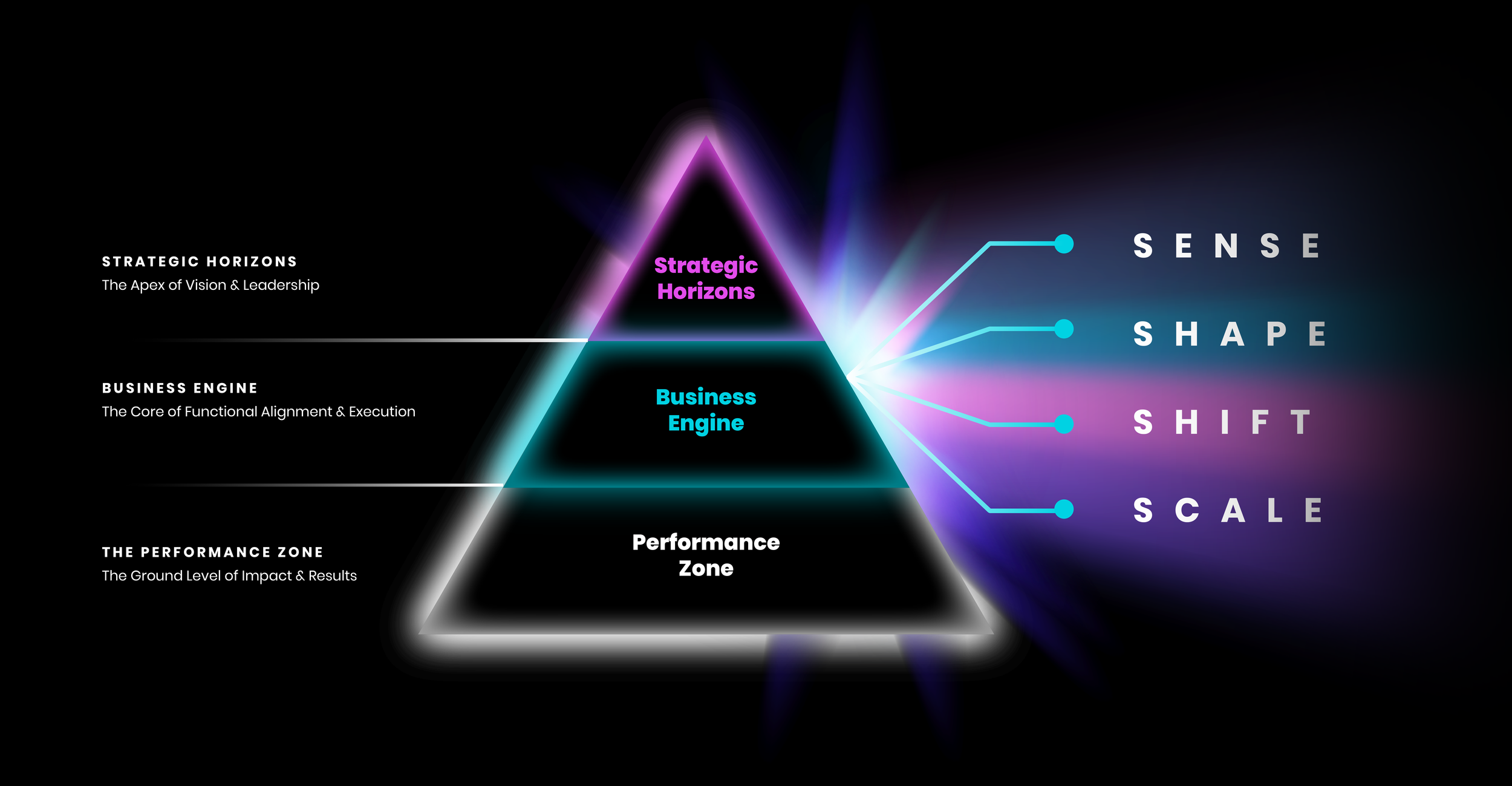The way we work
At Flux, we don’t offer generic consultancy services. We embed principles of action that help businesses move forward. We don’t follow rigid methodologies. We don’t give you a plan that will gather dust.
We work dynamically, collaboratively and with you to
co-create strategies that are interconnected throughout your business and can evolve with your business needs.
Network Intelligence
Leveraging our EaaS model to provide collective expertise across industries and disciplines with on-demand access to specialised expertise across the FluxB2B network.
Systems Thinking
Treating growth as an interconnected web of activities, not linear processes.
Adaptive Strategy
Creating living playbooks by developing dynamic strategies and actionable plans that evolve with market conditions and business needs.
Ecosystem Design
Building comprehensive growth systems vs. isolated marketing programs by creating adaptive growth architectures that align business strategy, market positioning, and implementation capabilities.
What We’re Solving For
We don’t turn up with a bunch of advice. We solve for:
Misalignment across leadership and teams.
Wasted time, energy and investment on the wrong priorities.
Strategy without effective execution, or execution without a sound strategy.
Change fatigue and stalled growth fuelling lack of clarity in shifting environments.
How We Help
Our clients don’t come to us asking for strategy.
They come because growth has stalled, teams are scattered, or the have big ambition but their next big move isn’t clear.
We help them find the signal in the noise, then co-create adaptive strategies that aligns leadership, teams, and traction.
We turn that clarity into actionable and momentum.
We accelerate and connect strategy to executable pathways, embed capability and support to activate the strategy in market.

“If we’re stuck trying to optimise the past, we can’t lead the future.”
- Gisela Montello-Bruce, Co-Founder | Strategic Director
Our FluxCode™ OS
At the core of our way of working is a dynamic system that connects vision with implementation, ensuring strategic intent turns into real-world impact.
Together, these layers form the foundation from which 4 forces of strategic motions emerge that enable businesses to remain adaptable, resilient, and primed for shifts and opportunity.
The Four Forces of Strategic Motion
Every organisation operates within a network of forces - internal and external, seen
and unseen, stable and shifting.
Our approach not only helps companies make sense of change - we also help them design for it, move with it, and stay ahead of it. This is strategy as an active system, not a static plan.

Why This Matters
Most businesses think of strategy as something you document and revisit once a year. That thinking is more than outdated.
Strategy is a living system - constantly sensing, shaping, shifting, and scaling.
Leaders are designing motion, not standing still waiting to react.
The strongest companies are not waiting for the market to tell them what to do, they create their own momentum.
Explore the FluxCode™ OS in Action
-
The Strategic Horizons layer is where companies define their future. It’s the vantage point from which leadership makes the high-impact decisions that set direction, establish priorities, and position the business for long-term success. This is the source of vision, ambition, and calculated intent - where opportunities are sensed, and strategic intent is shaped.
-
The Business Engine transforms strategy into momentum. It’s the operational layer that connects big-picture thinking with real-world execution. Here, teams align around strategic priorities, integrating capabilities, resources, and initiatives to propel the business forward. This is where the shift happens - from strategic intent to coordinated action, ensuring fluidity between leadership vision and market delivery.
-
The Performance Zone is where strategy meets reality. It’s the space where products, services, and experiences come to life, where outcomes are realised, market responses are measured, and continuous adaptation fuels progress. This is the proving ground of strategic motion, ensuring that what is envisioned at the top, translates into tangible, scalable success.
-
Where external movements shape the future.
Emerging trends, shifts, and competitive forces.
Early indicators of market opportunities or risks.
Customer and cultural signals that demand attention
Explore intuitive ideas.
Map the ecosystem.
-
Where business identity and positioning are crafted.
The intersection of vision, market opportunity, and capability
Defining what the business stands for, where it competes, and how it differentiates
Decision-making models that shape what’s next
Align business priorities, capabilities, and strategic focus.
Create a strategy that is flexible and built for real-world execution.
-
Where strategy moves from ideas to activation.
Translating strategy into execution and real-world traction
Move from planning to action, without time drag
Aligning teams, resources, and systems for sustained motion
Learning and iterating in real time to create momentum.
Establish a culture of learning and failure-safety.
-
Where businesses expand their impact.
Optimising process, systems and operations to grow and adapt effectively.
Strengthening for long-term strategic advantage
Getting Started
We believe that businesses at the edge of change shouldn’t be locked out by inflexible pricing. We invite you to invest what makes sense for you with our Open Price Pilot.
We’ll bring the strategic firepower either way.
All open-access engagements will pilot new strategic methods and build forward-thinking case studies.
All our clients typically start in one of three ways:
A Thinking Space
This is your starting point to unpack a key decision shift, resolve one key challenge quickly, and address the specifics that will help your business stay strong.
☞ PICK YOUR PRICE:
Range From: $950 - $1,500
An Opportunity Lab
A focused 10-day engagement to help leadership step out of the void, surface value gaps, and find the right market opportunity.
☞ PICK YOUR PRICE:
Range From: $5,000 - $8,500
A 4-Week Strategy Sprint
In shifting markets, speed without strategy is noise. When you can’t explain your value in today’s terms, you lose sales, traction, and trust.
☞ PICK YOUR PRICE:
Range From: $12,500 - $15,000
Market Team in a Box
Over 90 days, a focused team of fractional experts work to turn scattered effort into a cohesive growth engine – connecting strategy and execution as new growth initiatives are aligned and land in market.
☞ INVESTMENT PRICE:
Starting From: $30,000 (Scoped to requirements)










